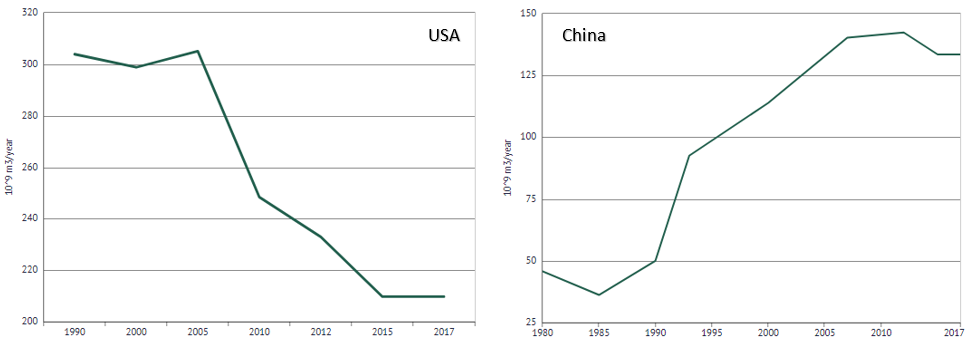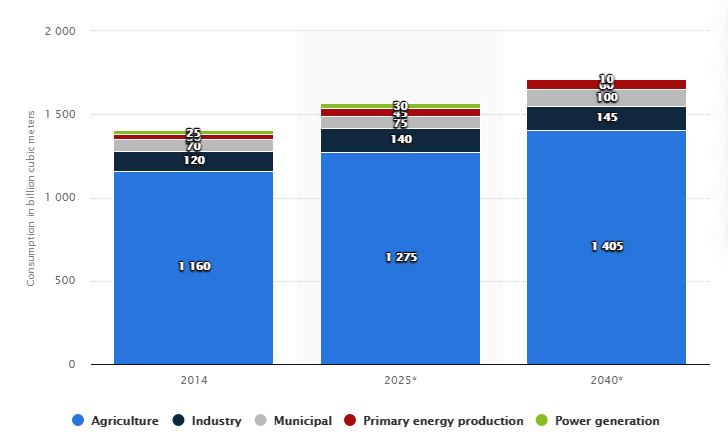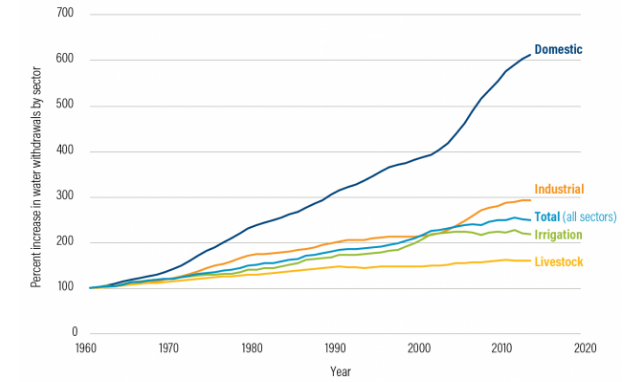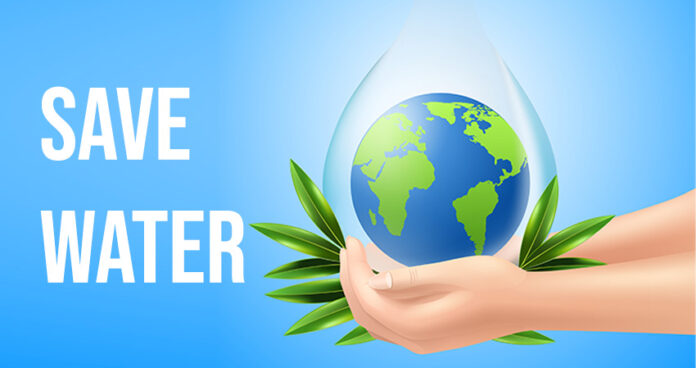Current trends in global water supply and demand suggest that humans have failed to value water as a scarce resource till now. According to reports by World Data Lab, more than 2.3 billion of the global population is facing water scarcity as availability per person has fallen below 500 cubic liters. By 2050, this decline in the water supply is expected to double and in the next 10 years, the global water demand is expected to increase by 50%. When waters run dry, the populations won’t be able to drink, produce food, or maintain hygiene resulting in the loss of life and economic activity. Understandably, natural water reserves in their diverse form are more than enough to last generations upon generations but the distribution tactics, ruthless use by industry, and poor management by the states have jeopardized the availability too. Due to this reason, need to save water has increased more than ever.
The attempt by human beings to manage the water resources for their sustenance has proven unsustainable so far. The process has disrupted the natural river flow system; dried up streams; polluted water bodies; and damaged ecosystems. In an urge to meet short-term economic goals the human beings have often ignored the long-term impacts of uncontrolled water usage on the environment, economy, water sustainability in particular regions, and ultimately global health. According to countless warnings and reports by United Nations, global freshwater has decreased 55% since 1960 while the demand continues to grow. The concerns about whether the countries will be able to meet their future demand for water consumption or not are growing over the last several decades.
The Need to Save Water for Human Survival
According to studies by the University of United Nations (UNU), 40% of the world population will face extreme water scarcity by 2035, putting increased pressure on ecosystems to provide freshwater. Scientists expect that if water availability is already low then it will inevitably result in the global scarcity of water, which would be a nightmare for upcoming generations since human beings can’t live so long without food and water.
Researchers have conducted many studies to identify the amount of water withdrawn by human beings for various activities including industry and agriculture. Vegetable and fruit farming, Textiles, meat production, beverages, and automotive are 5 major sectors that consume the most water. The report that intended to find out the status of the availability of freshwater, concluded that human activity consumed more water than humans themselves, as elaborated in the following paras.
How Much Water Industry Withdraws?
There are a lot of controversies regarding the causes of the boom in industrialization and urbanization, which made human beings exploit the natural resources of the planet more than ever. Environmental experts have argued that such developments have put increased stress on natural resources. Over the past few decades, water consumption has increased twice the size of the global population. Industry uses 20% of the clean water including renewable water resources and fossil water. Tailoring a simple t-shirt uses up to 2700 liters of water, which can sustain human life for more than 900 days. Moreover, creating a vehicle can take up to 150,000 liters of water.
The United States and China are the top two countries that use the most water for industrial usage annually. However, the US has started to decrease its industrial water withdrawal since 2004 whereas China’s usage has kept on rising exponentially during the period of 1990 – 2012.

China still uses less amount of water than the US for industrial purposes but withdraws the most amount i.e., 362 trillion gallons for its population of 1.5 billion. The US stands at 216 trillion gallons but still remains the top country to use more water per person than all the other countries.
How Much Water is used to Produce Food?
The Data shows that most of the amount is being used in the production of various industrial commodities, food, and energy. The ever-increasing population requires more food which further requires more water. Studies have revealed that agriculture requirements use 70% of the global water. According to projections made by Statista, these two sectors would be using 20% more water in the next 20 years.

Agriculture will continue to meet the global population demand, which would keep increasing the use of water resources. There are several needs of modern humans regarding food that require a lot of water. For example, producing a single loaf of bread can use up to 1 ton of water because of grain. Vegetables can also use hundreds of liters of water to produce only 1 kilogram of fresh stuff. Some of the thirstiest crops are wheat, cotton, rice, corn, and sugarcane.
How Much Water Households Withdraw?
Even though domestic water withdrawal is far less than production as per Statista data, it does not mean that the consumption is also low. According to the data by World Resource Institute, domestic demand for water grew 600% since the 1960s, way faster rate than any other sector.

The ever-increasing population and the demand for more homes, and cities require more water than ever. Furthermore, UNU expects the water demand for production to increase by 400% and households by 130% by 2050. Different studies have projected different trends but raised similar concerns to save water.
Other Factors Affecting Global Water Supply
To analyze the true impact of human activity on water resources, it is important to identify the factors that cause water scarcity in the first place. Besides the growth in population and demand, the major problem lies with water management. A universal problem of corruption, poor accountability, disasters, violence, poor maintenance of water infrastructure, and poor water sanitation are all inter-related crises that threaten the security of water.
According to a study by Levy & Sidel (2011) published in the American Journal of Public Health, approximately 97.5% of all global water is either salted or polluted. 70% of the remaining 2.5% is frozen and only around 0.3% of global water in lakes, rivers, and reservoirs is available for human use.
Issue of Water Unavailability due to Pollution
There are large bodies of water in some regions but the pollution has made them useless. The waste from human activity is still causing problems and starting to affect fossil water as well. Mining activity has led to the pollution of streams and rivers with dangerous chemical compounds. Humans are also unable to save water that is resting beneath the Earth. Pollutants can travel underground and pollute the centuries-old reserves of freshwater. It is not possible to measure how much of this water is inside the Earth but scientists do know that it won’t be back when it’s gone.
As far as sewage systems are concerned, UNU’s research indicated that 80% of the wastewater returns to the environment due to poor management. Nearly 1.8 billion humans worldwide are using contaminated water for drinking. 2.4 billion or one-third of the total world population has no improved sanitation facility. One in ten humans have no choice but to defecate in the open, which ends up in the water and ultimately back in the environment. The university estimated that approximately 112 billion USD per year is required to achieve the goals regarding the improvement of water supply, sanitation, and hygiene. It is 3 times the current investment in water sustainability programs.
Water pollution is even affecting aquatic life. In 2019 scientists found out freshwater shrimp in Suffolk to test positive for illegal drugs.
Water-Related Disasters
A lot of natural disasters in recent years have originated from water including floods, tsunamis, landslides, storms, and heatwaves. UNU’s Global Water Crises report analyzed that 90% of all-natural disasters are water-related. Between 1970 and 2010, the average population affected annually by flood increased from 33% to 70%. By the year 2050, this figure is also expected to rise along with climate change, loss of wetlands, deforestation, and rising sea levels putting around 2 billion population at risk. The UN kept warning about urban flash floods after massive floods of 2015 in the US, France, and Guatemala, that killed hundreds. UN stated that the changing climate, heavy rain, and rampant urbanization have helped these disasters to occur more often in the last 20 years. More than 107,000 humans died due to floods and landslides between 2000 and 2016.
Water-related disasters cause great damage to food crops, infrastructure, lives, livelihoods, and global health. The increased impact of these disasters is attributed to the magnitude of human development, unplanned urbanization, degradation of ecosystems, and failure to save water. Identifying the root cause of such high vulnerability to disasters and adopting proper measures of prevention still remains a great challenge for humans.
Water Infrastructure Issues
Poor infrastructure management is also one reason that hinders the efforts to save water. In developing nations, almost 11.8 billion gallons are wasted through leaks in infrastructure. This amount of water can facilitate a population of almost 200 million humans. In 2007, a study by UNU found out that 36% of the hand pumps installed in over 21 African countries were not working. Even though 60,000 hand pumps were being constructed in Africa on yearly basis. The problem of poor infrastructure management also persists in developed countries. These failures of systems related to water management often highlight governance errors. The water sector usually ignores accountability for the bad actors that prevents transparency and allows corruption. Institutional dysfunction and unethical practices and commonly reported from every region but of course impossible to measure.
Billions of dollars are being spent on the establishment of different water systems. Dams for example, which were supposed to save water from getting short, have been one of the key players in water scarcity. When humans build dams to power their improperly urbanized cities, they cause massive shortages in other communities. Moreover, those located downstream of the river flow also face issues with incomplete access to water. Only those living upstream benefit from the water in dams. According to an investigation by Vrije University Amsterdam, the world has invested more than 2 trillion USD on dams. It has only provided water for 20% of the global population and made it scarce for 23%.
Conflicts related to Water
Research also indicates that there have been violent conflicts over water in the past. However, the conflicts were never due to the lack of water, but due to the problematic water management by the nation-states.
At least 60% of flowing water in 260 river basins across 145 countries is shared by 2 or more countries where 40% of the world population lives. Due to this many countries highly depend on water resources that come from outside their national territory. For example, 76% of Pakistan’s water resources originate from outside the country. Less access to water has resulted in many conflicts over time. Even the longest river on Earth, Nile has limited water and 11 countries mutually depend on it heavily.
They have fought great wars since 1944 over the rights and access to Nile’s water resources. Agreements to strengthen the cooperation between Nile neighbors have only achieved so little. In fact, after 2007 the interests between upstream and downstream countries started to deviate. Ethiopia wanted to build a 6000 MW hydroelectric dam while Egypt was already struggling with the current amount of downstream river flow. Egypt does not even get much rainfall and depends on the Nile for 97% of its water requirements. Egypt has used its financial and political influence to hinder development in upstream nations but it is changing as many upstream nations have been getting financially strong too. The UN has warned that if Egypt is unable to save water, it can run out of it by 2025.
Need for Water Sustainability Solutions
Water-related development projects would have been successful if the potential changes in the environment, society, and climate were considered in achieving water sustainability. The studies on the subject demonstrate that business-as-usual would further widen the gap. Where some regions have enough water to waste, others face unstable ecosystems because of water scarcity. A rights-based approach is essential for water management while revising the plans.
Before applying any solution, the first step is to change the public perception about the value of water. Global citizens including businesses, governments and customers mostly view clean water as a commodity to monetize rather than a valuable resource. Water has helped some humans to be alive, healthy, and wealthy but at the same time, many others have been deprived of it making them prone to diseases.
Major responsibilities lie with corporations all over the world who fail to recognize basic human rights fundamentals in carrying out business activities. They can make sure that their operations don’t put local communities, poor populations, or indigenous people at risk of unsafe and insufficient water. They must save water by reducing usage, pollution, and damage to the freshwater ecosystem and be transparent in disclosing the adverse impacts of their activities.
Interdisciplinary research is required to manage depleting water supply. Humans may need to unlearn and relearn new methodologies to ensure effective use of natural resources to make seawater useable. Just like industries use transformative technologies to gain profits, the same can be done with water sustainability programs.
Desalination of Water
As for recommendations by the U.S. Environmental Protection Agency (EPA), desalination of saltwater can be one solution for addressing water shortages. Saltwater has excessive salinity levels that include too much concentration of Total Dissolved Solids (TDS) which makes it unusable for humans. The salinity of seawater is generally between 33,000 and 42,000 mg/L TDS while brackish fossil water is known to have up to 10,000 mg/L TDS. The WHO considers that water with less than 1,000 mg/L TDS is useable. Desalination can remove TDS from the sea and fossil water to generate a bit lower saline water stream for human use while keeping a high-salinity stream for waste. Increasing the amount of useable and reusable water can be one of the effective ways to save water for the next generations.
What Are Challenges
While it is necessary for human beings to save water to sustain their existence on this planet, the task is not simple and easy to achieve. The reason is that the process requires an overhaul of the ways the residents of the Earth live their lives. It just doesn’t need some performative actions by corporations like making Google Doodle on Earth day. In fact, the world may need to rethink the industrial and agricultural activity, consumption patterns, and even sharing of the resources among the nation-states. Such a solution is possible to achieve only when world leaders prioritize thinking beyond just national stakes and corporates are given with new rules of the game to make a profit, in order to guarantee the sustainability of the Earth’s resources and human life.


